Growing a rambutan tree (Nephelium lappaceum) can be one of the most rewarding experiences for tropical fruit lovers. With its exotic appearance, soft spiky red skin, and sweet, juicy flesh, rambutan is often called the cousin of lychee—and just as delicious. However, while rambutan trees can thrive beautifully in tropical and subtropical climates, they can also be surprisingly delicate.
Inspired by the YouTube video “5 Mistakes To Avoid When Growing Rambutan Trees”, this comprehensive guide will help you understand the most common pitfalls gardeners face when cultivating rambutan—and how to avoid them. Whether you’re planting from seed or caring for a young grafted tree, these insights will ensure your rambutan grows healthy, strong, and productive.
Understanding the Rambutan Tree
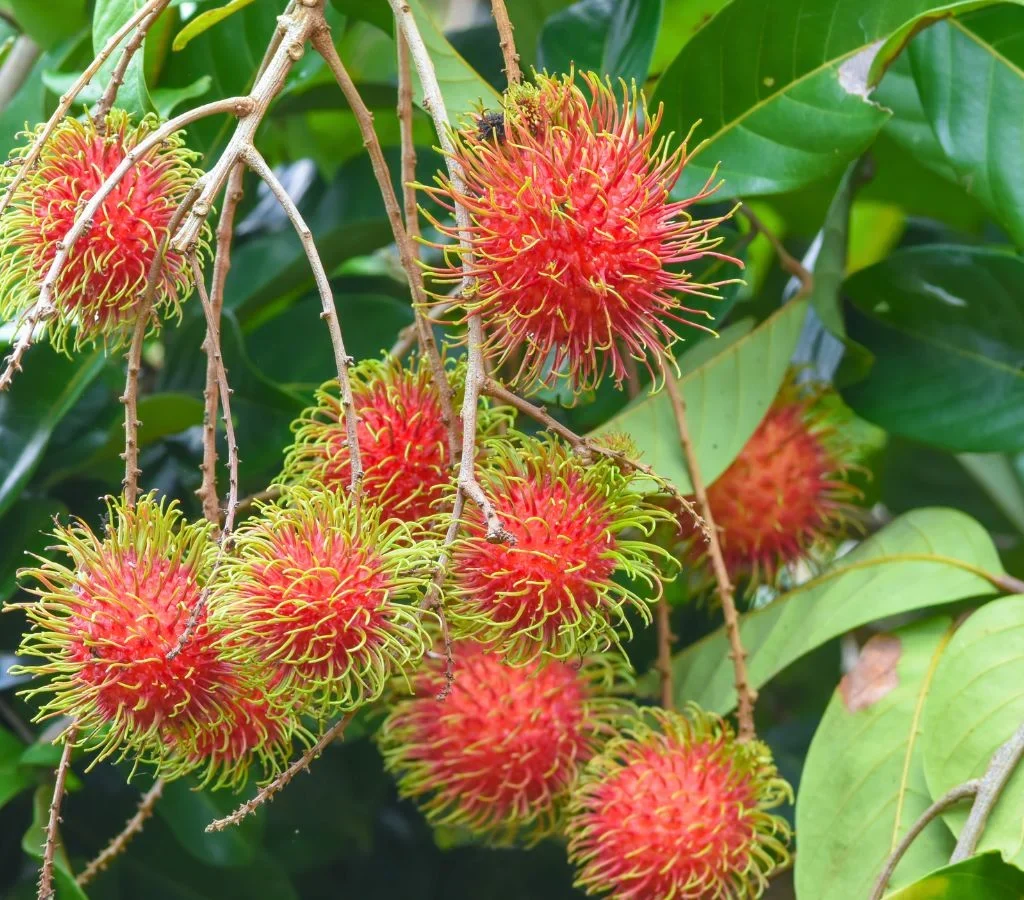
Before diving into the mistakes, it’s important to know your plant.
- Scientific Name: Nephelium lappaceum
- Family: Sapindaceae (same family as lychee and longan)
- Origin: Southeast Asia
- Growth Habit: Evergreen tree that can reach up to 20–30 feet (6–9 meters) tall
- Climate Needs: Warm, humid environment with temperatures between 25–35°C (77–95°F)
Rambutan trees love consistent warmth, moisture, and rich soil, but they are sensitive to poor growing conditions. Even small mistakes in care can significantly delay fruiting or damage the tree’s health.
Let’s explore the five most common mistakes gardeners make—and the simple solutions to avoid them.
Mistake #1: Planting in Poor or Unsuitable Soil
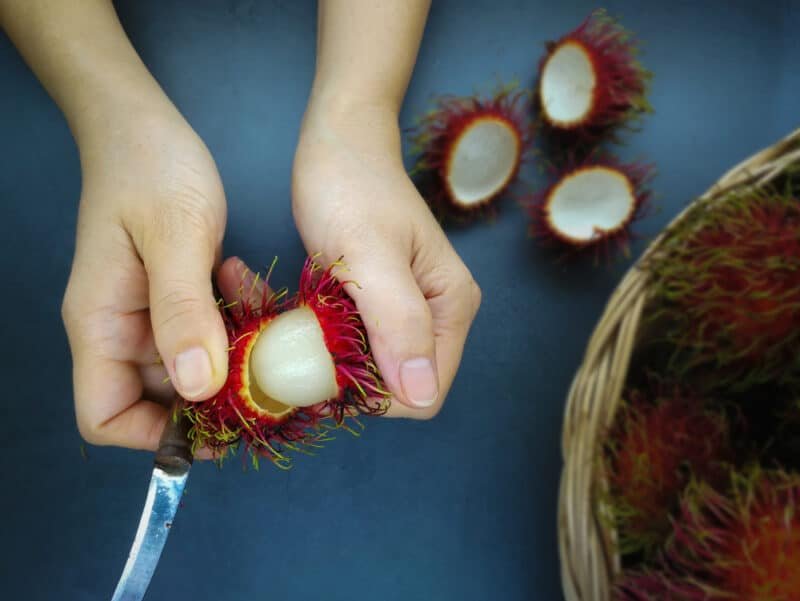
The number one mistake when growing rambutan trees is planting them in the wrong soil type. Rambutan has deep roots that need oxygen, moisture, and good drainage. Planting in heavy clay or waterlogged soil suffocates the roots and leads to root rot—a fatal problem for tropical trees.
Symptoms of Poor Soil:
- Yellowing or wilting leaves
- Stunted growth despite regular watering
- Roots that appear dark and mushy
How to Fix It:
- Use well-draining soil. The ideal mix should be loamy with a balance of sand, compost, and organic matter.
- Mix 40% garden soil, 30% sand or perlite, and 30% compost or coco peat.
- Avoid areas where water collects after rain. If you’re growing in a pot, ensure there are large drainage holes.
- Maintain soil pH between 5.5 and 6.5 for optimal nutrient absorption.
Healthy, breathable soil allows roots to grow deep and ensures steady fruit development in later years.
Mistake #2: Giving Too Much or Too Little Sunlight
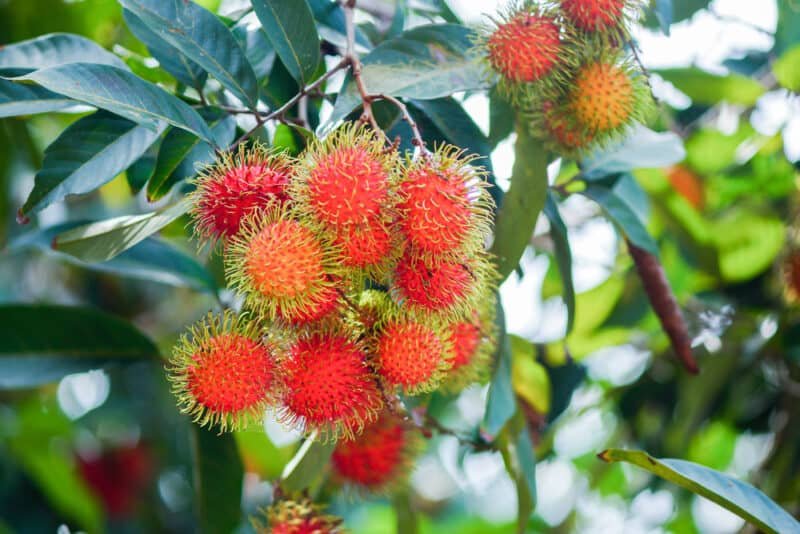
Many new gardeners underestimate how light affects rambutan growth. While it’s a tropical tree that enjoys warmth, young rambutan plants are sensitive to harsh, direct sunlight. Too much exposure, especially during midday, can scorch tender leaves, while too little sunlight causes weak, leggy growth and delayed flowering.
Symptoms of Light Stress:
- Brown, crispy leaf edges (sunburn)
- Pale, drooping leaves (insufficient light)
- Slow growth and few new shoots
How to Fix It:
- For young trees (under 2 years): Keep them in partial shade—morning sunlight with filtered afternoon light is perfect.
- For mature trees: Once established, rambutan thrives best in full sun for at least 6–8 hours daily.
- If growing in containers, rotate the pot weekly for even sunlight exposure.
Finding the right light balance ensures lush foliage and healthy future fruiting.
Mistake #3: Overwatering or Underwatering
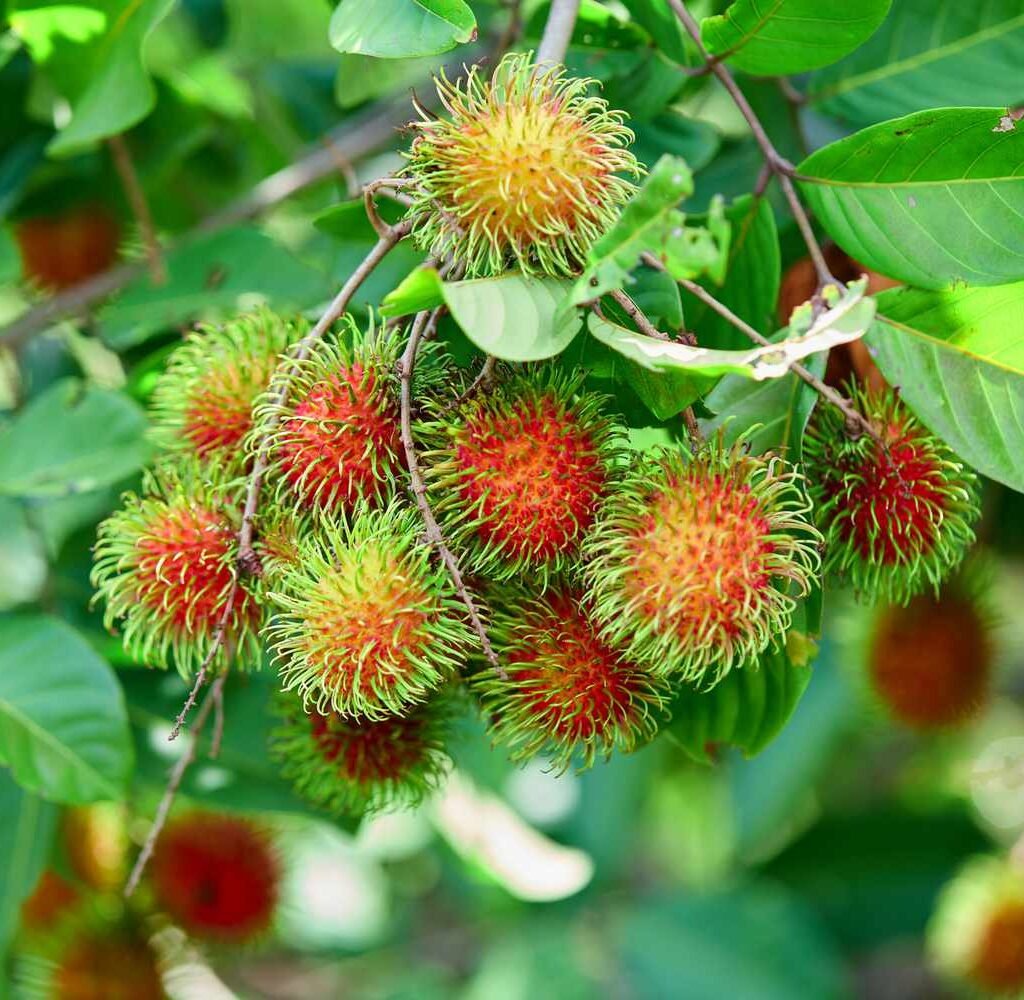
Rambutan trees love moisture—but that doesn’t mean they love soggy soil. Overwatering is a common and deadly mistake that leads to root rot, while underwatering causes stress, leaf drop, and poor flowering.
How to Identify Overwatering:
- Constantly wet soil surface
- Mushy roots
- Fungal smell near the base
Signs of Underwatering:
- Dry, brittle leaves
- Curling or yellowing foliage
- Cracked soil surface
How to Fix It:
- Water deeply but infrequently. Let the top 2–3 inches of soil dry slightly between waterings.
- Use mulch (like dry leaves or coconut husk) to retain soil moisture and prevent rapid evaporation.
- In summer, water every 2–3 days; in cooler months, reduce to once or twice a week.
- Ensure proper drainage if growing in containers or raised beds.
Pro tip: Rambutan roots prefer a consistent moisture level—think evenly moist, never soggy.
Mistake #4: Ignoring Nutrient Balance and Fertilization
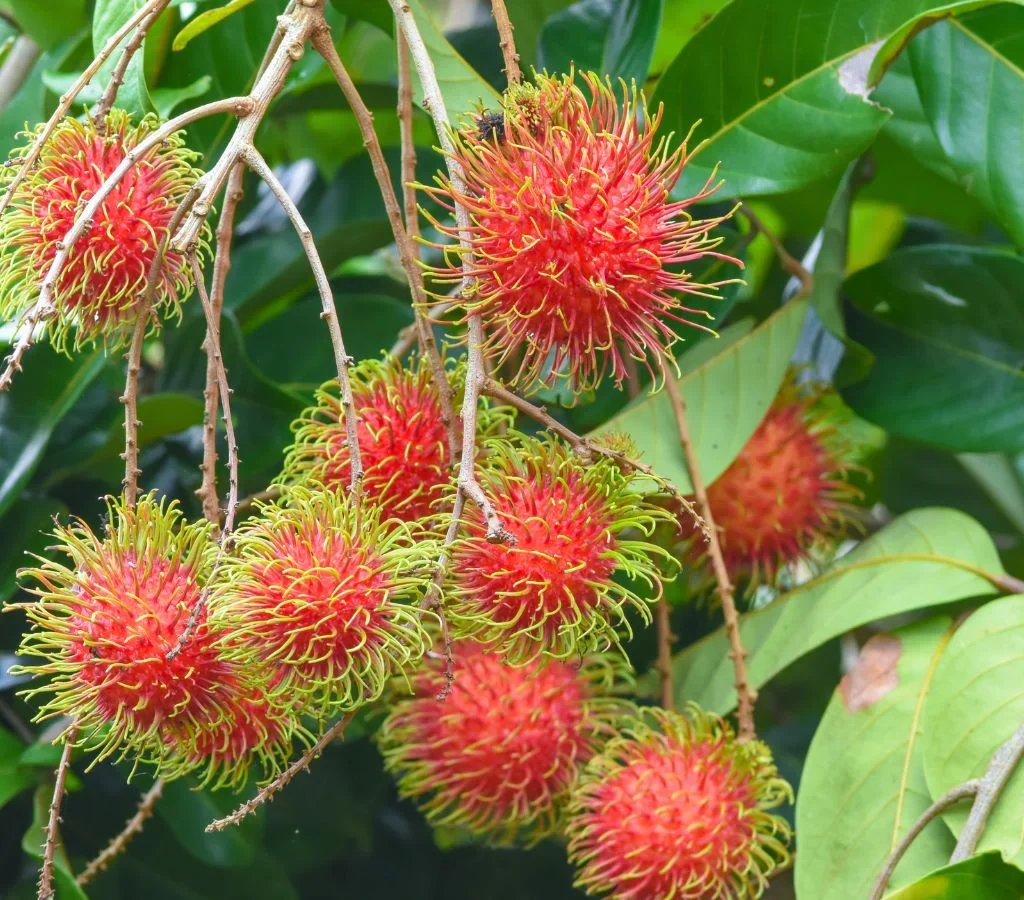
Rambutan trees are heavy feeders. One of the most common mistakes is either over-fertilizing with chemicals or not fertilizing at all. Both extremes harm the plant.
Without enough nutrients, the tree struggles to grow and rarely flowers. Too much chemical fertilizer, on the other hand, burns the roots and kills beneficial soil microbes.
Nutrient Deficiency Symptoms:
- Pale, yellow leaves
- Poor branching or sparse foliage
- Small or deformed fruits
How to Fix It:
Use a balanced feeding schedule combining organic and mineral nutrients:
- Every 6–8 weeks: Add organic compost or cow manure to enrich soil texture.
- Every 2 months: Feed with a balanced NPK fertilizer (10-10-10) for general growth.
- During flowering and fruiting: Switch to a fertilizer higher in potassium (K) and phosphorus (P), like 5-10-20, to promote fruit set.
- Micronutrients: Occasionally add Epsom salt (magnesium sulfate) or seaweed extract for greener leaves.
Avoid dumping large amounts of fertilizer at once. Feed in small, consistent doses throughout the year.
Healthy nutrition means your rambutan tree will reward you with lush foliage, strong branches, and eventually, clusters of sweet red fruits.
Mistake #5: Neglecting Climate and Pollination Needs
Rambutan trees are climate-sensitive, and ignoring their environmental needs is another big mistake that can prevent fruiting. These trees thrive in warm, humid climates and struggle in cold, windy, or dry areas.
Additionally, many people don’t realize that rambutan trees are not self-pollinating—you often need both male and female flowers, or a bisexual tree, to get fruit.
Symptoms of Climate or Pollination Issues:
- Flower drop without fruit formation
- Poor or no flowering at all
- Leaves turning brown or curling in dry air
How to Fix It:
For Climate Management:
- Maintain humidity around 70–80% if possible. In dry areas, mist the leaves or use a humidity tray.
- Protect trees from cold winds by planting near a wall or using a windbreak.
- If temperatures drop below 15°C (59°F), cover the tree with a transparent plastic sheet or move it indoors if potted.
For Pollination:
- If possible, grow at least two rambutan trees—one male and one female—or a grafted variety known for self-pollination.
- Encourage natural pollinators like bees by planting nectar-rich flowers nearby.
By addressing these two factors, you’ll greatly improve your tree’s chances of flowering and producing fruit successfully.
Bonus Tip: Patience Is Key
One unspoken “mistake” gardeners often make is expecting quick results. Rambutan trees are naturally slow growers. If grown from seed, they may take 5–7 years to bear fruit, while grafted varieties may start in 2–3 years.
Use this time to strengthen your plant’s roots and structure through good care. A strong foundation leads to abundant harvests later.
Additional Tips for Successful Rambutan Growth
To ensure your rambutan thrives long-term, keep these best practices in mind:
- Regular Pruning: Trim weak or crossing branches to improve airflow and sunlight penetration.
- Mulching: Add a 2-inch layer of organic mulch to retain soil moisture and suppress weeds.
- Pest Management: Watch for aphids, mealybugs, and fruit flies. Neem oil spray is a safe, natural solution.
- Container Growing: If growing in pots, upgrade to larger containers (at least 60–80 cm in diameter) every 2–3 years.
- Consistent Monitoring: Observe your plant weekly for any signs of stress or disease—early detection saves time and effort.
Conclusion
Growing a rambutan tree is a deeply rewarding process, but it demands patience, consistency, and the right knowledge. As highlighted in “5 Mistakes To Avoid When Growing Rambutan Trees,” avoiding these five critical errors can make the difference between a struggling plant and a thriving tropical beauty.
To recap, ensure your rambutan tree has:
Well-draining, nutrient-rich soil
Balanced sunlight exposure
Consistent watering without waterlogging
Proper feeding with organic nutrition
Suitable climate conditions and pollination support
When you avoid these common mistakes, you set your rambutan tree on the path to health and abundance. In a few years, you’ll be rewarded with glossy green foliage, fragrant blossoms, and delicious, juicy rambutan fruits hanging from your very own tree.
So, whether you’re planting in the ground or a large container, remember: the key to success lies not in perfection, but in careful observation and learning from nature. With love and patience, your rambutan tree will grow into a symbol of tropical beauty and sweet reward.
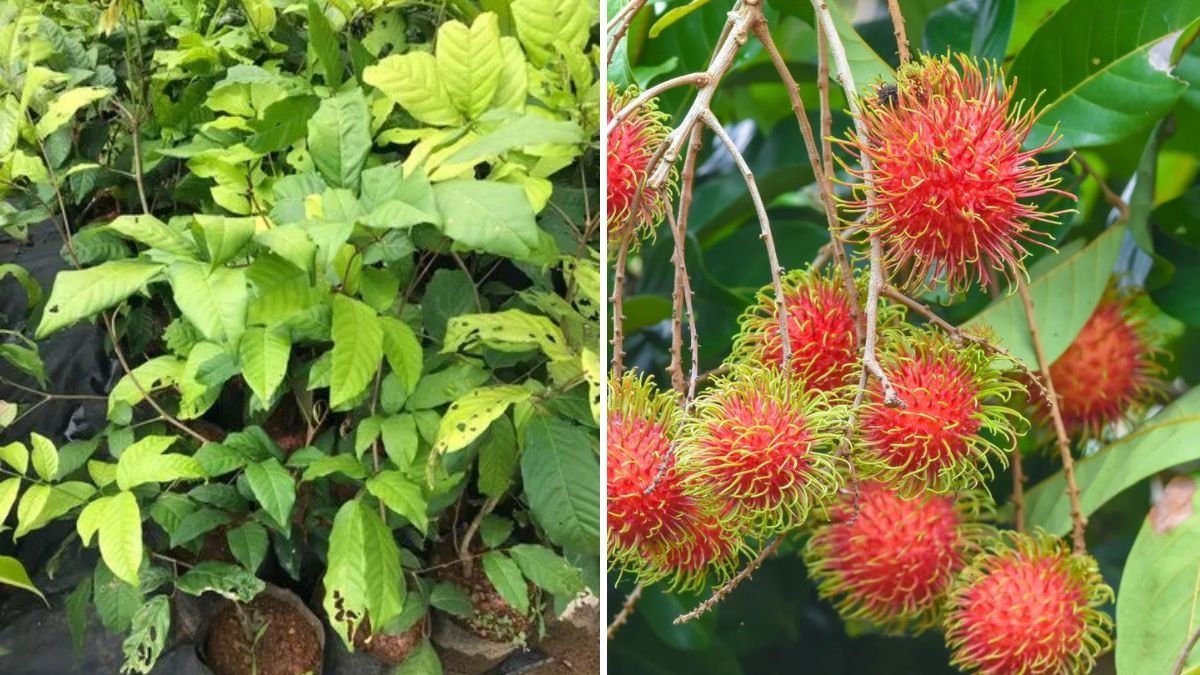





Leave A Comment